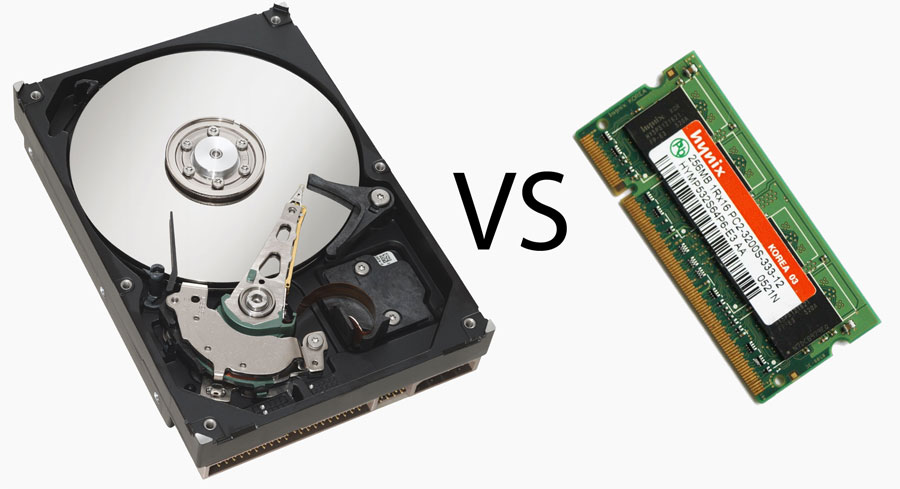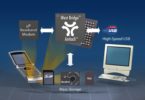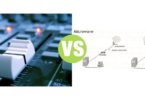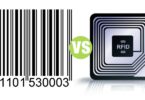Memory vs Hard Drive
Summary: Difference Between Memory and Hard Drive is that Memory consists of electronic components that store instructions waiting to be executed by the processor, data needed by those instructions, and the results of processing the data information. While hard drive is a storage device that contains one or more inflexible, circular platters that use magnetic particles to store data, instructions, and information.

Memory
Memory consists of electronic components that store instructions waiting to be executed by the processor, data needed by those instructions, and the results of processing the data (information). Memory usually consists of one or more chips on the motherboard or some other circuit board in the computer. Memory stores three basic categories of items:
- The operating system and other system software that control or maintain the computer and its devices;
- Application programs that carry out a specific task such as word processing;
- The data being processed by the application programs and resulting information. This role of memory to store both data and programs is known as the stored program concept.

Bytes and Addressable Memory
A byte (character) is the basic storage unit in memory. When application program instructions and data are transferred to memory from storage devices, the instructions and data exist as bytes. Each byte resides temporarily in a location in memory that has an address. An address simply is a unique number that identifies the location of the byte in memory. Lets clear this by showing how seats in an opera house (image above) are similar to addresses in memory: (1) a seat, which is identified by a unique seat number, holds one person at a time, and a location in memory, which is identified by a unique address, holds a single byte; and (2) both a seat, identified by a seat number, and a byte, identified by an address, can be empty. To access data or instructions in memory, the computer references the addresses that contain bytes of data.
Memory Sizes
Manufacturers state the size of memory and storage devices in terms of the number of bytes the chip or device has available for storage. Recall that storage devices hold data, instructions, and information for future use, while most memory holds these items temporarily. A kilobyte (KB or K) is equal to exactly 1,024 bytes. To simplify memory and storage definitions, computer users often round a kilobyte down to 1,000 bytes. For example, if a memory chip can store 100 KB, it can hold approximately 100,000 bytes (characters). A megabyte (MB) is equal to approximately 1 million bytes. A gigabyte (GB) equals approximately 1 billion bytes. A terabyte (TB) is equal to approximately 1 trillion bytes.
Hard Drive
A hard disk is a storage device that contains one or more inflexible, circular platters that use magnetic particles to store data, instructions, and information. The system unit on most desktop and notebook computers contains at least one hard disk. The entire device is enclosed in an airtight, sealed case to protect it from contamination. A hard disk that is mounted inside the system unit sometimes is called a fixed disk because it is not portable. With respect to a storage medium, the term portable means you can remove the medium from one computer and carry it to another computer.
Current personal computer hard disks have storage capacities from 160 GB to 2 TB and more. Home users store documents, spreadsheets, presentations, databases, e-mail messages, Web pages, digital photos, music, videos, and software on hard disks. Businesses use hard disks to store correspondence, reports, financial records, e-mail messages, customer orders and invoices, payroll records, inventory records, presentations, contracts, marketing literature, schedules, and Web sites.
Traditionally, hard disks stored data using longitudinal recording, which aligned the magnetic particles horizontally around the surface of the disk. With perpendicular recording, by contrast, hard disks align the magnetic particles vertically, or perpendicular to the disk’s surface, making much greater storage capacities possible. Experts estimate that hard disks using perpendicular recording provide storage capacities about 10 times greater than disks that use longitudinal recording. Hard disks are read/write storage media. That is, you can read from and write on a hard disk any number of times.
Also Read:
Difference Between Internal and External Drive Bays
Difference Between Motherboard and Hard Drive
Difference Between Flash Memory and Hard Drive
Difference Between Ram and Hard Drive







Leave a Comment
You must be logged in to post a comment.